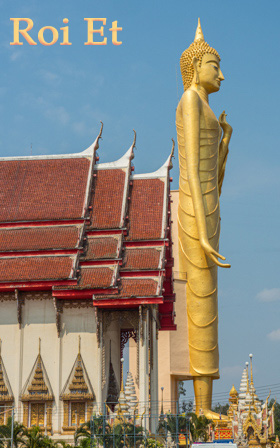


|
Roi Et is a small city in the Isaan region of Thailand. It is built around an artifical lake and island in the center. The central part of the city is surrounded by a moat. Coming overland from Ubon Ratchathani I was intially attracted here by high standing Buddha at Wat Burapha Phiram. Another attraction in this very pleasant city is the Roi Et National Museum. It features many exhibits showcasing the ancient history and culture of the region. |
The lake that Roi Et is built around is called Bung Phlan Chai. In the middle is an island with a recreational park which people use for exercise or general relaxation. On the lake there are various boats to rent.

Wat Burapha Phiram is located in the north-east of central Roi-Et near the moat. When I arrived everything was closed. The highlight of the Wat is the 59.2 meter high standing Buddha, known as Phra Phuttha Rattanamongkhon Mahamuni or Luangpho Yai. It is the highest standing Buddha in Thailand. When open, it is possible to climb inside to the top.


The Buddha was built from re-inforced concrete and completed in 1973.

What ultimely was of more interest to me, partly from Wat Burapha Phiram being closed, was the National Museum.
Originally founded by Dr. Ko Sawadiphanit to display local silk textiles and handicrafts. It was later expanded by the Fine Arts Department, to include the province's archeology, history and way of life.
There has been a long tradition of hand woven textiles in Roi Et.
|
Traditionally the craft was passed from mother to daughter and performed on hand looms. In the Isaan women can gain economic status from weaving. Traditionally each village had its own signature designs. This is starting to change as weavers become aware of other village designs. The weaving method used is called Mudmee. Both silk and cotton are used to make Mudmee textiles. Mudmee weaving started in this region about 3000 years ago. The single yarns are pre-dyed in multiple colours. Sometimes the the warp (lengthwise) yarn can be a single colour, sometimes the weft (horizontal) yarn can be a single colour. The pattern emerges as weaving progresses. This method is complicated but is capable of producing very intricate patterns. Natural dyes are dyes extracted from various parts of certain trees such as bark, core, leaves seed or fruit. |

Hand Loom Silk
|
The colours which the ancestors used such as dark blue were obtained from indico, red from cocus lacca insects, black from curcuma domestica or khamin.

Today most weavers prefer to use modern chemical dyes introduced at the end of the nineteen century. However, some groups of people are aware of chemical dye pollution and are returning to natural dyes and researching plants to get different shades of colours.
Other exhibits show aspects of traditional Isaan life.
One exhibit shows a long-distance caravan. After the harvest people would collect local products such as cattle, agricultural products, salt and silk fabrics for exchange with other communities in the Isaan and sometimes as far away as Bangkok. There were usually 30-40 ox-carts in each caravan. The ox-cart used to carry goods and also served as a mobile home.

Other exhibits are reconstructions of rooms in traditional Isaan dwellings.


Boon Phawed of Buddhist Mahachat preaching ceremony is arranged in March or the 4th month of every year. Now, this ceremony is being promoted to be the most important ceremony in Roi-et province.

The museum has a section devoted to instruments used in Isaan music. Morlam is the traditional music of the Isaan and Laos. The songs are based on poems depicting rural life in which the singer composes the music around the tones of the poem.
Regional people are highly skilled in using local products to build musical instruments.
On display are the wot, phin (lute), khene, ponglang, blowing horn and a mouth harp. The wot is a circular pan pipe made from bamboo. It is frequently used with the ponglang, a xylophone which is hit with a hardwood hammer.

The khene is a type of mouth organ often played accompanied by a phin, a lute with two or three metal strings which are plucked by a pick.
Other exhibits are from the Dvaravati and Lopburi and earlier periods. These include Buddhas, jars and votive moulds.
The standing Buddha dates from the Dvaravati period between the 8th and 10th centuries. The remainder, including the votive mould and cast, date from eht 12th century Lopburi period.


Roi Et is a pleasant city with enough attractions to keep people busy for a couple of days. I hope to return one day, epecially as it has gained a another major attraction since I visited, the wot shaped Roi Et Tower.
